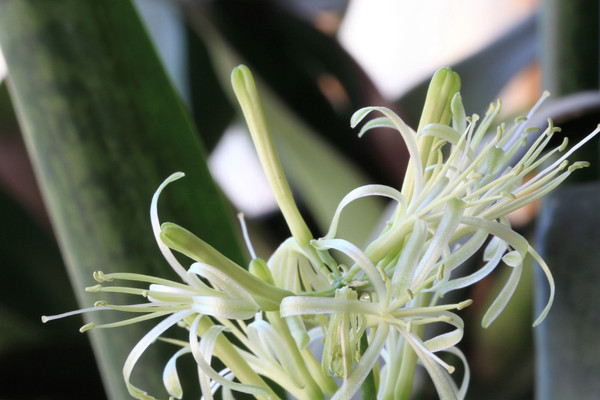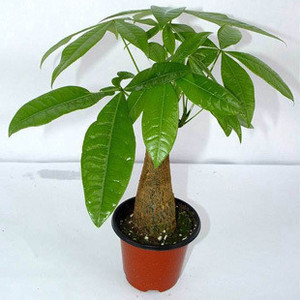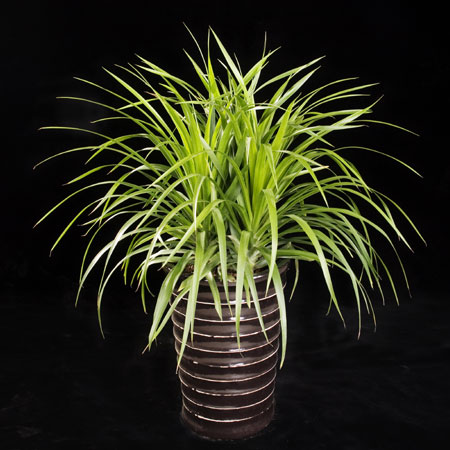Culture methods and matters needing attention of tiger skin sword orchid
Raising a tiger skin sword orchid at home is a good choice. Tiger skin sword orchid, also known as tiger tail orchid, has erect leaves with gray-white and dark green tiger-tail-shaped stripes, resolute posture, strange and interesting; it has many varieties, great changes in plant shape and leaf color, exquisite and chic; it has a strong ability to adapt to the environment, and is a kind of indomitable plant. Phnom Penh tiger skin orchid belongs to the genus Polygonaceae, which is one of more than 60 species of tiger skin orchid with high ornamental value and is distributed in both tropics and subtropics. The following is the editor of the net to talk in detail about the breeding methods and matters needing attention of tiger skin sword orchid.

Culture methods and matters needing attention of tiger skin sword orchid
Ecological habits: light-loving long-day plants, winter cultivation cloudy days to increase light, afraid of cold. The suitable growth temperature is 20-25 ℃ in daytime and 10-15 ℃ at night. Through the dormant corms, the bulbs germinated at 4-5 ℃, and the plants froze to death when cultivated at 0 ℃ in winter. Do not tolerate waterlogging and avoid stagnant water in the cultivated land. For the sandy loam with good drainage and fertile soil, the pH value of 5.6-6.5 is better.
The main diseases are:
a. Penicillium rot, harvest and transportation, try not to hurt the seed bulb; soak in 2% potassium permanganate solution before planting: hour; pull out the diseased plant at any time during the growth process.
b. For dry rot, the disease-free mother ball should be selected when planting, and the diseased plant should be pulled out in time in the process of growth.
C. "blind flower" is a physiological disease, which mostly occurs in protected cultivation in winter. The method of prevention is to ensure suitable temperature and light, and select varieties that are resistant to low temperature and short sunshine.
The main pest is double-line mucilophilic slug, which can be sprayed with lime water and ammonia water; sprinkle lime powder around the garden to prevent it from entering; artificial culling.
Soil.
Tiger skin orchid soil needs loose, strong air permeability, so when preparing soil for tiger skin orchid, we must pay attention to the rotten leaves of 2 big 3, plus 1 big 3 garden soil, and keep in mind that the soil must be loose and breathable, otherwise the water will not evaporate easily and lead to rotting of the rhizome. It can also be mixed with 3 parts of fertile garden soil and 1 part of cinder, and then add a small amount of bean cake or chicken manure as base fertilizer.
Reproduction
It can be propagated by ramet and cuttage. All varieties of tiger skin orchid can be divided into plants, generally combined with changing pots in spring, the method is to cut the overgrown leaves into several clumps, each with leaves, but also a section of rhizome and sucking buds, which can be planted in the pot respectively.
Yellow rimmed or silver-veined varieties of tiger skin orchid use cutting method, when the temperature is above 15 ℃, the practice is to take leaves 5-10 cm long, slightly dry after cutting into the sand, cutting can not be reversed, cutting after spraying new high-fat film, on the plant surface, can prevent bacteria infection, improve the ability to resist natural disasters, improve the intensity of photosynthesis, pay attention to maintain a certain humidity, after a month can take root.
Temperature.
Tiger skin orchid has a high requirement for temperature. The suitable temperature for its growth is 20-30 ℃, and it stops growing when it is below 13 ℃. The lowest temperature in winter should not be lower than 10 ℃, otherwise the base of the plant will rot and the whole plant will die.
Humidity
During the growing period, the tiger skin orchid should be watered rather than wet. When new plants sprout at the root neck in spring, they should be watered properly to keep the basin soil moist, and do not let water accumulate in the basin in the rainy season. Usually, clean water can be used to scrub the foliar dust to keep the leaves clean and bright.
Generally speaking, if the soil is loose, it is watered twice a week; in winter, it is colder and only needs to be watered once.
Fertilizer
Tiger skin orchid does not have high requirements for fertilizer. 15% cake fertilizer and water can be applied every half a month in the growing season. Spraying Zhuangtuanling can make plant stems stout, leaves thick, leaves fresh and tender, and plants luxuriant. In the peak growth period, fertilizer can be applied once or twice a month, and the amount of fertilizer should be less; if only nitrogen fertilizer is applied for a long time, the markings on the leaves will become dim, so compound fertilizer is generally used. You can also evenly bury 3 holes of cooked soybeans in the soil at the edge of the basin, with 10 grains in each hole, be careful not to come into contact with the roots, and stop fertilizing from November to March of the following year.
Disease and pest
The common diseases of tiger skin orchid are leaf spot and anthracnose, which can be treated by spraying more than 50% carbendazim; common pests are harmful to weevil, and 1000 times of fenitrothion EC can be used to kill them.
Adult tiger skin orchid can blossom every year, and fragrance, but mainly to observe the leaves. This kind of plant is drought-resistant, moisture-resistant, shade-resistant, can adapt to a variety of harsh environment, suitable for garden beautification or potted, for advanced flower indoor plants, very suitable for decorating living room, study lamp place.
According to experts, tiger skin orchid can absorb more than 80% of indoor harmful gases, especially for formaldehyde, especially in newly renovated houses, and tiger skin orchid can also protect against radiation. The above tiger skin orchid culture methods and matters needing attention for your reference!
Culture methods and matters needing attention of tiger skin sword orchid
Tiger skin sword orchid, also known as tiger skin orchid, is a kind of swallow tail plant, and it is also the most common foliage plant in life. it can purify the air and beautify the environment, and the leaf shape is huge, with tiger skin-like patterns on the surface, so it is of high ornamental value and is easy to breed. However, if you want to raise a good tiger skin sword orchid, you also need to master certain breeding methods, and to understand what you need to pay attention to when breeding. Here is my detailed introduction of this knowledge. If you like this kind of plant, you can focus on it.
1. Soil
When raising tiger skin sword orchid, you should choose loose, fertile and breathable soil. When preparing basin soil, you can use 2/3 rotten leaf soil to add 1/3 garden soil, or you can use three portions of fertile garden soil and add a loose cinder to mix well. finally, add reasonable bean cake or chicken dung as base fertilizer.
2. Reproduction
Tiger skin sword orchid can be propagated by ramet and cuttage, of which ramet is the most common, it can be combined with changing pots in spring, the specific operation method is to cut the overdense leaves into multiple, cosmetic contact lenses not only with leaves, but also with a certain number of rhizomes and sucking buds, so it is easy to survive after transplanting it into a new flowerpot.
3. Temperature
Tiger skin sword orchid in breeding, the appropriate temperature is very important, tiger skin sword orchid temperature requirements are particularly high, usually it is suitable to grow in an environment of 20 to 30 degrees, when the indoor temperature is lower than 13 degrees, it will stop growing, and the lowest temperature in winter can not be lower than 10 degrees, otherwise its roots will rot and die.
4. Humidity regulation
During the breeding period, humidity regulation is also very important. When he is in the peak growing season, he should abide by the principle that it would rather be dry than wet. Just after entering spring, it is in the budding period, and it can properly pour more water to keep the pot soil moist. However, after entering the rainy season, stagnant water must not appear in the flowerpot. In order to increase air humidity, clean water can be used to wipe his leaves, which can increase humidity. It can also keep its leaves clean and shiny.
Tiger skin sword orchid picture culture method of tiger skin sword orchid
Tiger Pilan, also known as tiger tail orchid, brocade orchid, millennium orchid, this is a very good foliage plant, now let's take a look at how this kind of reproduction.
Tiger skin sword orchid culture method tiger skin sword orchid is a kind of foliage plant, most of the time people just to see the tiger skin sword orchid leaves, has the same appearance as the tiger tail, looks particularly beautiful. The propagation method of tiger skin sword orchid is also a very common method of plant division and cutting.
1. Cuttage Propagation of Tiger skin Cymbidium
Tiger skin sword orchid can first select some strong leaves, first cut out 6 centimeters, and then insert the cut leaves into the basin soil, the basin uses some mixed sand and gravel, so it will be more breathable, so that tiger skin sword orchid is particularly easy to take root, usually to maintain the humidity and permeability of the basin soil, so that it can take root after a month, usually put in some ventilated and transparent environment, so it is easy to take root.
two。 The method of ramet propagation of tiger skin sword orchid
For some plants that grow well and have many plants, we can cut off the roots of the tiger skin sword orchid and plant them separately, so that the tiger skin sword orchid is separated from a large plant and becomes an independent plant. this is very easy to grow, because after the tiger skin sword orchid is independent, it has the original good root system, after the split, it can absorb more sunlight and benefit the growth of the tiger skin sword orchid.
- Prev

How to raise red sandalwood trees in potted plants and their growing environment
Red sandalwood can be used as furniture or medicinally, and when it comes to the feeling of red sandalwood to the editor, it has a strange fragrance. Red sandalwood tree (scientific name: PterocarpusindicusWilld.), also known as sandalwood rosewood. Red sandalwood is an evergreen subtree with compound leaves and butterfly-shaped flowers
- Next

What are the culture methods and matters needing attention of Dragon Blood Tree?
It was only then that the editor knew that this plant was called Dragon Blood Tree and that he was ignorant. Next, the editor of the net will introduce the Dragon Blood Tree. Dragon blood tree, also known as: bleeding tree, blood-activating holy medicine, plant birthday. It is a valuable Yunnan red medicine-Draconis Draconis, also known as Qilin Draconis, which is as famous as Yunnan Baiyao.
Related
- Fuxing push coffee new agricultural production and marketing class: lack of small-scale processing plants
- Jujube rice field leisure farm deep ploughing Yilan for five years to create a space for organic food and play
- Nongyu Farm-A trial of organic papaya for brave women with advanced technology
- Four points for attention in the prevention and control of diseases and insect pests of edible fungi
- How to add nutrient solution to Edible Fungi
- Is there any good way to control edible fungus mites?
- Open Inoculation Technology of Edible Fungi
- Is there any clever way to use fertilizer for edible fungus in winter?
- What agents are used to kill the pathogens of edible fungi in the mushroom shed?
- Rapid drying of Edible Fungi

